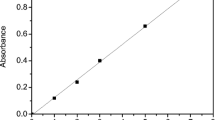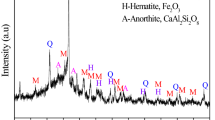Abstract
Raw coal fly ash (RCFA) was recycled as three kinds of adsorbents by hydroxyl anion (OH−), hydrogen ion (H+), and thermal activation, respectively, for the adsorption of Cr(VI) from water. The H+ activation can explore the adsorptive potential of RCFA more effectively than the other two methods. The specific surface areas of the adsorbents are 12.33, 16.32, and 13.89 m2 g−1 for OH−, H+, and thermal activation, respectively. The adsorption process follows the pseudo-second-order kinetic model and the Langmuir model better and exhibits exothermic property. The activation energy (20.65–31.88 kJ mol−1) and the negative Gibbs free energy reveal that the adsorption is a physical and spontaneous process. The adsorbents derived from OH−, H+, and thermal activation can be used at least 5, 7, and 4 times, respectively, while the one from H+ activation has the best adsorption capacity (6.41 μg g−1 for the first run). The adsorption process can introduce other metallic/toxic elements, but within the Chinese standard. The preparation cost of the H+ activation is $1103 ton−1 adsorbent, while the treatment cost is $1.6 ton−1 water. The more accurate parameters in the pseudo-second-order kinetic model and Langmuir model can be calculated by nonlinear method and provided by the error function of the sum of the squares of the errors.





Similar content being viewed by others
References
An, C. J., Yang, S. Q., Huang, G. H., Zhao, S., Zhang, P., & Yao, Y. (2016). Removal of sulfonated humic acid from aqueous phase by modified coal fly ash waste: equilibrium and kinetic adsorption studies. Fuel, 165, 264–271.
Arshadi, M., Mousavinia, F., Abdolmaleki, M. K., Amiri, M. J., & Khalafi-Nezhad, A. (2017). Removal of salicylic acid as an emerging contaminant by a polar nano-dendritic adsorbent from aqueous media. Journal of Colloid and Interface Science, 493, 138–149.
Barrera-Diaz, C. E., Lugo-Lugo, V., & Bilyeu, B. (2012). A review of chemical, electrochemical and biological methods for aqueous Cr(VI) reduction. Journal of Hazardous Materials, 223, 1–12.
Belviso, C. (2018). State-of-the-art applications of fly ash from coal and biomass, a focus on zeolite synthesis processes and issues. Progress in Energy and Combustion Science, 65, 109–135.
Choi, H. A., Park, H. N., & Won, S. W. (2017). A reusable adsorbent polyethylenimine/polyvinyl chloride crosslinked fiber for Pd(II) recovery from acidic solutions. Journal of Environmental Management, 204, 200–206.
Dash, S., Chaudhuri, H., Gupta, R., Nair, U. G., & Sarkar, A. (2017). Fabrication and application of low-cost thiol functionalized coal fly ash for selective adsorption of heavy toxic metal ions from water. Industrial and Engineering Chemistry Research, 56, 1461–1470.
Eliche-Quesada, D., Sandalio-Perez, J. A., Martinez-Martinez, S., Perez-Villarejo, L., & Sanchez-Soto, P. J. (2018). Investigation of use of coal fly ash in eco-friendly construction materials, fired clay bricks and silica-calcareous non fired bricks. Ceramics International, 44, 4400–4412.
Franus, W., Wiatros-Motyka, M. M., & Wdowin, M. (2015). Coal fly ash as a resource for rare earth elements. Environmental Science and Pollution Research, 22, 9464–9474.
Inglezakis, V. J., & Zorpas, A. A. (2012). Heat of adsorption, adsorption energy and activation energy in adsorption and ion exchange systems. Desalination and Water Treatment, 39, 149–157.
Kapoor, A., & Yang, R. T. (1989). Correlation of equilibrium adsorption data of condensable vapours on porous adsorbents. Gas Separation and Purification, 3, 187–192.
Kumar, V., Matsuda, M., & Miyake, M. (2008). Resource recovery from coal fly ash waste, an overview study. Journal of the Ceramic Society of Japan, 116, 167–175.
Koukouzas, N., Vasilatos, C., Itskos, G., Mitsis, I., & Moutsatsou, A. (2010). Removal of heavy metals from wastewater using CFB-coal fly ash zeolitic materials. Journal of Hazardous Materials, 173, 581–588.
Hu, L. M., Zhang, G. S., Liu, M., Wang, Q., & Wang, P. (2018). Enhanced degradation of bisphenol A (BPA) by peroxymonosulfate with Co3O4-Bi2O3 catalyst activation: effects of pH, inorganic anions, and water matrix. Chemical Engineering Journal, 338, 300–310.
Lotlikar, N. P., Damare, S. R., Meena, R. M., Linsy, P., & Mascarenhas, B. (2018). Potential of marine-derived fungi to remove hexavalent chromium pollutant from culture broth. Indian Journal of Microbiology, 58, 182–192.
Leung, R., Venus, C., & Zeng, T. (2018). Structure-function relationships of hydroxyl radical scavenging and chromium-VI reducing cysteine-tripeptides derived from rye secalin. Food Chemistry, 254, 165–169.
Marquardt, D. W. (1963). An algorithm for least-squares estimation of nonlinear parameters. Journal of the Society for Industrial and Applied Mathematics, 11, 431–441.
Miretzky, P., & Cirelli, A. F. (2010). Cr(VI) and Cr(III) removal from aqueous solution by raw and modified lignocellulosic materials, a review. Journal of Hazardous Materials, 180, 1–19.
Ma, Z. S., Liu, D. G., Zhu, Y., Li, Z. H., Li, Z. X., Tian, H. F., & Liu, H. Q. (2016). Graphene oxide/chitin nanofibril composite foams as column adsorbents for aqueous pollutants. Carbohydrate Polymers, 144, 230–237.
Ng, J. C. Y., Cheung, W. H., & McKay, G. (2002). Equilibrium studies of the sorption of Cu(II) ions onto chitosan. Journal of Colloid and Interface Science, 255, 64–74.
Porter, J. F., McKay, G., & Choy, K. H. (1999). The prediction of sorption from a binary mixture of acidic dyes using single- and mixed-isotherm variants of the ideal adsorbed solute theory. Chemical Engineering Science, 54, 5863–5885.
Rengaraja, S., Yeon, J. W., Kim, Y., Jung, Y., Ha, Y. K., & Kim, W. H. (2007). Adsorption characteristics of Cu(II) onto ion exchange resins 252H and 1500H, kinetics, isotherms and error analysis. Journal of Hazardous Materials, 143, 469–477.
Seidel, A., & Gelbin, D. (1988). On applying the ideal adsorbed solution theory to multicomponent adsorption equilibria of dissolved organic components on modified carbon. Chemical Engineering Journal, 43, 79–89.
Seidel-Morgenstern, A., & Guiochon, G. (1993). Modelling of the competitive isotherms and the chromatographic separation of two enantiomers. Chemical Engineering Journal, 48, 2787–2797.
Soco, E., & Kalembkiewicz, J. (2015). Removal of copper(II) and zinc(II) ions from aqueous solution by chemical treatment of coal fly ash. Croatica Chemica Acta, 88, 267–279.
Sočo, E., & Kalembkiewicz, J. (2011). Control of Cr(VI) content in waste coal fly ash. In M. J. B. Murria (Ed.), Management of Hazardous Residues Containing Cr(VI) (pp. 317–340). New York: Nova Science Publishers Inc.
Tauanov, Z., Shah, D., Inglezakis, V., & Jamwal, P. K. (2018). Hydrothermal synthesis of zeolite production from coal fly ash, a heuristic approach and its optimization for system identification of conversion. Journal of Cleaner Production, 182, 616–623.
Uzarowicz, L., Skiba, M., Leue, M., Zagorski, Z., Gasinski, A., & Trzcinski, J. (2018). Technogenic soils (Technosols) developed from fly ash and bottom ash from thermal power stations combusting bituminous coal and lignite. Part II. Mineral transformations and soil evolution. Catena, 162, 255–269.
Vereshchagina, T. A., Kutikhina, E. A., Solovyov, L. A., Vereshchagin, S. N., Mazurova, E. V., Chernykh, Y. Y., & Anshits, A. G. (2018). Synthesis and structure of analcime and analcime-zirconia composite derived from coal fly ash cenospheres. Microporous and Mesoporous Materials, 258, 228–235.
Wang, W. X., Ye, Z. B., & Li, F. (2016). Removal of oil from simulated oilfield wastewater using modified coal fly ashes. Desalination and Water Treatment, 57, 9644–9650.
Wang, N. N., Zhao, Q., & Zhang, A. L. (2017a). Catalytic oxidation of organic pollutants in wastewater via a Fenton-like process under the catalysis of HNO3-modified coal fly ash. RSC Advances, 7, 27619–27628.
Wang, N. N., Chen, J. Q., Zhao, Q., & Xu, H. (2017b). Study on preparation conditions of coal fly ash catalyst and catalytic mechanism in a heterogeneous Fenton-like process. RSC Advances, 7, 52524–52532.
Wang, N. N., Hao, L. L., Chen, J. Q., Zhao, Q., & Xu, H. (2018). Adsorptive removal of organics from aqueous phase by acid-modified coal fly ash, preparation, adsorption, and Fenton regenerative valorization of “spent” adsorbent. Environmental Science and Pollution Research, 25, 12481–12490.
Wu, P. F., Tang, Y. Y., & Cai, Z. W. (2018). Dual role of coal fly ash in copper ion adsorption followed by thermal stabilization in a spinel solid solution. RSC Advances, 8, 8805–8812.
Xi, D. L., Sun, Y. S., & Liu, X. Y. (1995). Environment monitoring. Beijing: Higher Education Press.
Yao, Z. T., Ji, X. S., Sarker, P. K., Tang, J. H., Ge, L. Q., Xia, M. S., & Xi, Y. Q. (2015). A comprehensive review on the applications of coal fly ash. Earth-Science Reviews, 141, 105–121.
Funding
This work was supported by the National Natural Science Foundation of China (grant number 51808039, 21677018); Science and Technology Projects of Beijing Municipal Education Commission (grant number KM201910017008); and Jointly Projects of Beijing Natural Science Foundation and Beijing Municipal Education Commission (grant number KZ201810017024).
Author information
Authors and Affiliations
Corresponding authors
Ethics declarations
Conflict of Interest
The authors declare that they have no conflict of interest.
Additional information
Publisher’s Note
Springer Nature remains neutral with regard to jurisdictional claims in published maps and institutional affiliations.
Electronic supplementary material
ESM 1
(DOCX 985 kb)
Rights and permissions
About this article
Cite this article
Wang, N., Han, Y. & Li, S. Adsorption Characteristic of Cr(VI) onto Different Activated Coal Fly Ashes: Kinetics, Thermodynamic, Application Feasibility, and Error Analysis. Water Air Soil Pollut 230, 154 (2019). https://doi.org/10.1007/s11270-019-4215-9
Received:
Accepted:
Published:
DOI: https://doi.org/10.1007/s11270-019-4215-9




